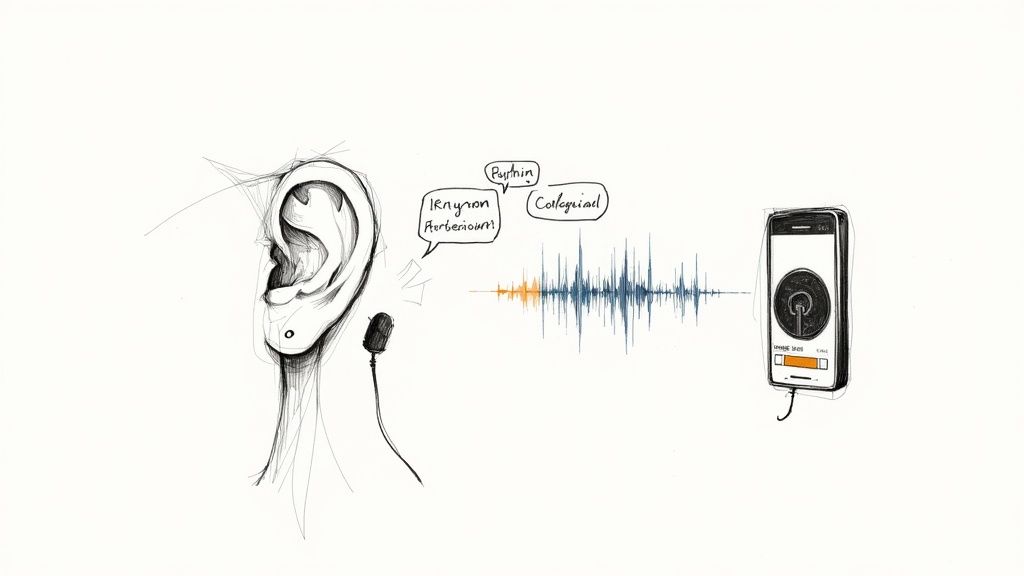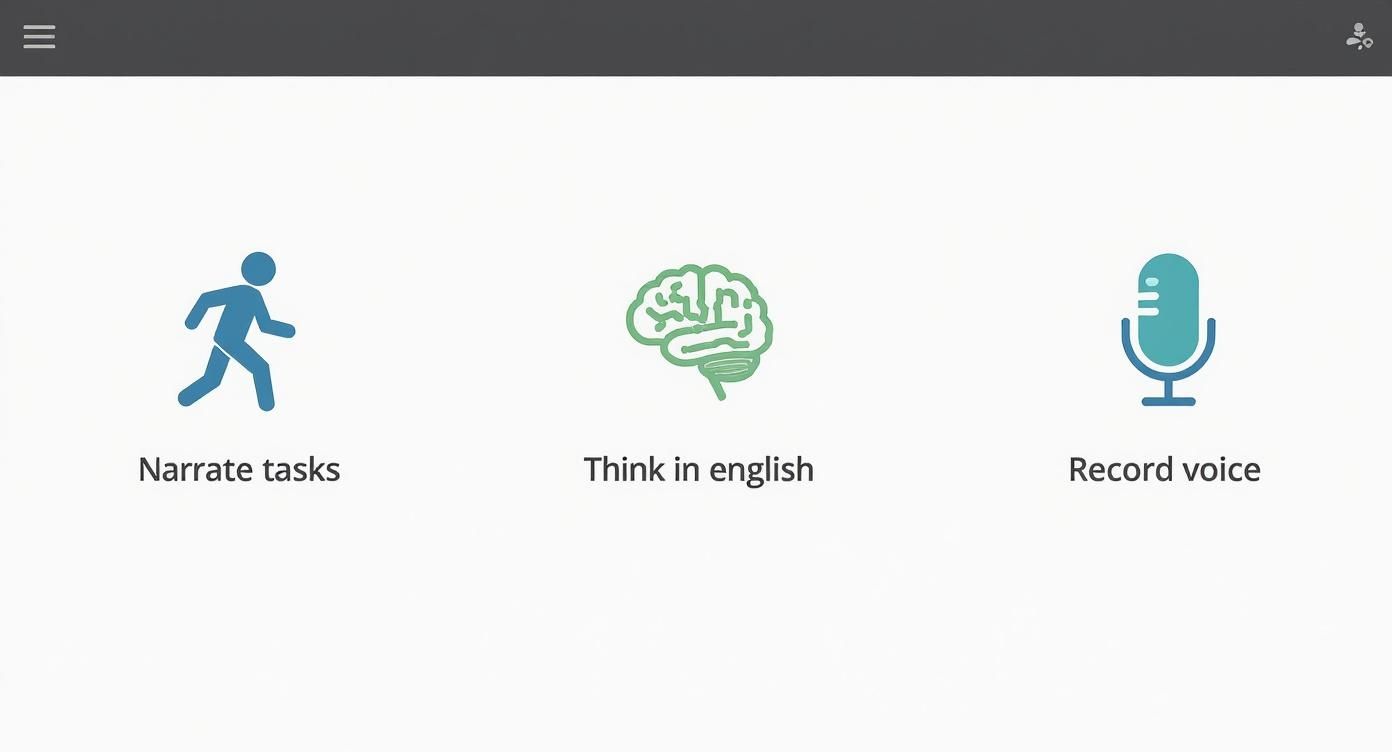how can i speak english fluently: Proven Methods for Fluency
If you want to speak English fluently, you need a solid foundation. But it's probably not what you think. It’s less about memorising endless lists of vocabulary and more about understanding the music of the language. It’s also about setting practical goals and creating daily habits that turn your world into a practice ground.
Building Your Foundation for Speaking Fluently
Many learners get stuck thinking the path to fluency is paved only with grammar books and flashcards. Those tools are helpful, of course, but they're only one part of the picture. The real secret is shifting your focus from just knowing things to actually doing them.
Think of it like learning to play an instrument. You can memorise all the notes, but you can't create music until you understand rhythm, timing, and feeling.
This practical approach is especially important in a place like Singapore. While about 80% of the population can speak English, only around 36% are native speakers. That means millions have successfully learned English as a second language, making it the main language for business, school, and everyday life. You can read more about Singapore's high English proficiency on teast.co.
To build your own solid base, you need to concentrate on the core elements that make your speech sound natural and confident.
Master the Music of English
Fluency isn't just about what you say; it's about how you say it. The "music" of English is something native speakers use without even thinking. By focusing on these elements, you’ll not only be easier to understand but you'll also sound much more natural.
- Pronunciation: This is all about making individual sounds clearly. Pay close attention to the vowel and consonant sounds that are different from your native language.
- Intonation: This is the natural rise and fall of your voice. It’s what signals the difference between a statement and a question, and it adds emotion to your words.
- Rhythm and Stress: English is a stress-timed language. This means certain syllables in a word, and certain words in a sentence, get more emphasis than others. Getting this rhythm right is a game-changer for sounding fluent.
Key Takeaway: Don't just learn words; learn their melody. A powerful trick is to listen to native speakers—on podcasts, in films, anywhere—and try to mimic their speech patterns. This helps you internalise the natural flow of English.
Set Practical and Achievable Goals
"I want to speak English fluently" is a fantastic ambition, but as a goal, it's far too vague to be useful. Real progress comes from breaking that big dream down into small, manageable, and measurable steps. This strategy keeps you motivated and gives you a clear path forward.
Instead of one huge target, try setting specific, short-term objectives. For example:
- "This week, I will learn and use five new phrases in a real conversation."
- "Every day for the next month, I will spend 15 minutes narrating my activities out loud in English."
- "By the end of this month, I will hold a 10-minute conversation with my language partner without switching back to my native tongue."
These kinds of goals are concrete. They give you something tangible to work towards, and every time you hit one, you build confidence and momentum. That's what keeps you going for the long haul.
If you’re looking for a more structured path, exploring dedicated English classes for adults in Singapore can give you a curriculum built around mastering these foundational skills.
By focusing on the sound of the language and setting realistic daily targets, you're creating a powerful and sustainable routine. This foundation doesn’t just prepare you to speak; it prepares you to communicate with clarity and confidence.
Master Active Listening to Speak More Naturally
Most learners think the path to fluency is paved with one thing: speaking more. And while practice is crucial, it’s only half the story. The real secret to sounding less like a textbook and more like a native speaker is to radically improve your input. That’s where active listening comes in.
Think about it. Passive listening is what you do when a TV show is on in the background. You hear it, but you're not really absorbing the language. Active listening, on the other hand, is a focused, deliberate exercise. It’s about understanding not just what is said, but how it's said.
This means you stop listening just to get the gist and start listening like a detective. You're hunting for clues in the rhythm, slang, and emotional tone of the speaker. This simple shift turns listening from a receptive skill into your most powerful tool for refining your own speech.
What to Listen For Beyond the Words
So, what should you be tuning your ears into? Instead of just following the plot of a Netflix series, start paying attention to the subtle details that make speech sound authentic.
- Intonation and Rhythm: Notice how a speaker's voice naturally goes up at the end of a question? Or how it falls to signal they've finished a thought? Listen for the words they stress in a sentence—those are the ones carrying the real meaning.
- Colloquialisms and Slang: Real people rarely talk like your grammar book. Keep an ear out for common idioms (like "bite the bullet"), phrasal verbs ("figure it out"), and all the informal slang that peppers casual conversation.
- Sentence Flow: How do speakers connect their ideas so smoothly? They use transition words you might overlook, like "anyway," "so," or "that being said." Hearing these in context will help you weave them into your own speech.
- Emotional Colour: So much of communication isn't in the words themselves. Listen for the subtle tells of sarcasm, excitement, or hesitation in a person's voice. What specific words or tones signal those feelings?
Key Insight: Active listening closes the gap between the English you learned in a classroom and the English people actually use every day. It's like finally getting access to the unwritten rules of conversation that native speakers just know.
Turn Listening into Active Practice
Once you know what to listen for, you can transform any podcast, video, or conversation into a powerful learning session. The goal is to stop being a passive audience member and start actively engaging with the material.
Two of the most effective ways to do this are through shadowing and targeted transcription. Honestly, they can feel a bit challenging at first, but stick with them. The payoff for your fluency is huge.
The Shadowing Technique Explained
Shadowing is exactly what it sounds like: you mimic a native speaker in real-time. You listen to a short audio clip and repeat what they say, as they say it, trying to match their pronunciation, speed, and intonation as perfectly as you can.
Here’s how to get started:
- Find a Short Clip: Grab just 15-30 seconds of clear audio. A snippet from a podcast or a monologue from a TV show is perfect.
- Listen First: Play it once or twice just to get a feel for the rhythm and content.
- Shadow Without the Script: Now, play it again and try to speak along with the recording. Don't stress about perfection; the goal is just to keep up.
- Shadow With the Script: Next, find the transcript (many podcasts and YouTube videos have them). Read along with the audio, but this time, really focus on matching the speaker’s stress patterns and pitch.
- Record and Compare: This is the magic step. Record yourself shadowing, then play it back and compare it to the original. You'll immediately hear where you can improve, whether it's a tricky vowel sound or an unnatural rhythm.
Targeted Transcription for Detail
Transcription is another fantastic exercise that forces your brain to process every single sound. Instead of just repeating, you write down exactly what you hear. It’s amazing what you pick up on.
- Pick a short audio clip (1-2 minutes).
- Write it out word-for-word, pausing and replaying as many times as you need.
- Check your version against the official transcript.
- Analyse the differences. Did you miss contractions like "gonna" or "wanna"? Did you mishear a phrasal verb? This is where you find your specific weaknesses and fix them.
By weaving these active listening strategies into your routine, you're training your ear to catch the subtle music of fluent English. Before you know it, you won't just be hearing it—you'll be speaking it.
Weave Daily Speaking Exercises Into Your Life
If you want to know how you can speak English fluently, consistency is your secret weapon. Forget about cramming for hours on a Saturday. Real, lasting fluency comes from small, manageable speaking habits you build into your daily routine, not from intense, sporadic study sessions.
This is all about turning those "dead" moments—your commute, your morning coffee, or even washing the dishes—into powerful opportunities to practise. The goal is to move beyond the generic advice of "just talk more" and adopt concrete exercises that sharpen specific skills.
Narrate Your World in English
One of the simplest yet most effective exercises is to become the commentator of your own life. As you go about your day, describe what you're doing, seeing, and thinking out loud, in English. It’ll feel a bit odd at first, but this technique is fantastic for building automaticity—that's the ability to produce language without having to think hard about it.
For instance, when you're making breakfast:
- "Okay, I'm opening the fridge now to get the eggs."
- "I need to be careful not to burn this toast."
- "This coffee smells amazing this morning."
This constant, low-pressure stream of words trains your brain to form English sentences on the fly. You're not worried about perfect grammar or being judged; you're simply connecting actions and objects with their English names, which is a core step toward speaking naturally.
Start Thinking Directly in English
The biggest hurdle for many learners is the habit of translating in their heads. You form a sentence in your native language, translate it word for word, and then try to say it. This process is slow, clunky, and often leads to unnatural-sounding English. The trick is to train your brain to skip that translation step altogether.
Crucial Tip: The aim is to make English the language of your internal monologue. This might sound daunting, but you can start small. Begin by just naming objects around you in English in your mind. From there, move on to simple thoughts like, "I'm hungry," or "I need to check my email."
Bit by bit, increase the complexity. Try planning your day or reflecting on a movie you watched entirely in English. This mental workout is one of the most direct ways to make your spoken English faster, smoother, and far more intuitive.
Use Your Phone as a Speech Coach
Your smartphone is probably one of the best tools you have for improving your speaking. Just use the voice recorder app to capture yourself talking, then listen back with a critical ear. This exercise gives you invaluable, objective feedback that’s hard to get any other way.
Here’s a simple routine you can try:
- Pick a Topic: Choose something easy, like your favourite hobby or what you did yesterday.
- Speak for One Minute: Record yourself talking about it for 60 seconds straight. Don't stop.
- Listen and Analyse: Play the recording back. What do you hear? Are there a lot of filler words like "um" or "ah"? Awkward pauses? Repeated grammar mistakes or pronunciation issues?
- Repeat and Refine: Record yourself on the same topic again, but this time, focus on fixing just one or two of the issues you noticed.
This self-correction loop is incredibly powerful. It shines a light on your specific weaknesses and gives you the power to fix them on your own terms. For a more playful and challenging way to work on your pronunciation, you could also try some tricky tongue twisters in English.
Just look at Singapore for proof that these daily habits work. The country consistently ranks among the top for English proficiency in Asia. The 2025 EF English Proficiency Index, which analysed data from 2.2 million adults, gave Singapore a "Very High" proficiency score. This indicates a near-native C1 level of English among the population. This success is largely thanks to policies that weave English into the fabric of daily life, from schools to workplaces, proving that consistent, daily exposure is what truly builds fluency. You can check out more details about these global English proficiency rankings on globalenglishtest.com.
By making these small but mighty exercises a part of your daily rhythm, you turn language learning from a chore into a natural habit. This consistent, daily effort is what builds the muscle memory you need to speak English fluently and with real confidence.
Find and Maximise Your Speaking Opportunities
Knowing the theory is one thing, but actually finding people to talk to? That's a whole different ball game. The real secret to speaking English fluently is getting the words out of your head and into the real world. You need to find—or create—spaces where you feel comfortable enough to talk, stumble over words, and improve without feeling judged.
The good news is that these opportunities are everywhere, more so now than ever before. From online apps that connect you with people across the globe to local groups right in your neighbourhood, you can build a practice routine that actually fits your life.
Connect With Global Partners Online
The internet has completely changed the game for language learners. Apps like Tandem and HelloTalk were built for one reason: to connect you with native speakers who want to learn your language in return. It’s a simple trade—you help them, they help you.
But to make these exchanges worthwhile, you need a plan. Don't just slide into DMs with a generic "hi". Instead, build a profile that clearly outlines what you're looking for. For example, mention you want a serious partner for a 30-minute speaking session, twice a week.
When you connect with someone, suggest a structure for your calls. Maybe you spend 15 minutes speaking only in English, then switch to their language for the next 15 minutes. This simple rule ensures both of you benefit. Being upfront about your goals helps you find people who are just as committed as you are.
Insider Tip: Don't be shy about asking for feedback. I often start my calls by saying, "Please feel free to correct any big mistakes I make. I really want to learn!" This gives your partner the green light to help you, turning a casual chat into a proper learning session.
Finding the right platform can make a huge difference. There are several popular options out there, each with its own vibe and set of features.
Comparing Language Exchange Platforms
| Platform | Best For | Key Feature | Cost |
|---|---|---|---|
| Tandem | Serious learners seeking structured exchanges | Built-in correction tools and topic prompts | Freemium (core features are free) |
| HelloTalk | Casual chats and cultural exchange | Integrated translation and social media-like feed | Freemium (limited translations for free) |
| iTalki | Formal lessons and paid tutoring | Professional tutors and community teachers | Pay-per-lesson (varies by tutor) |
| Speaky | Quick, on-the-fly conversations | Simple interface focused on immediate connection | Mostly free |
Ultimately, the best platform is the one you actually use. Try a couple out and see which community feels right for you.
Find Your Voice in Local Communities
As great as online chats are, nothing quite replaces the buzz of a real, face-to-face conversation. Joining a local club or meetup can be a fantastic way to practise your English in a supportive, real-world environment.
Try looking for groups that match your personal interests. A few ideas include:
- Toastmasters International: A globally recognised organisation focused on public speaking. It’s a structured place to give speeches, practise thinking on your feet, and get genuinely helpful feedback.
- Language Exchange Meetups: Websites like Meetup.com are full of groups dedicated to language practice. These are often relaxed get-togethers in cafes where you can chat with native speakers and other learners.
- Hobby Clubs: This is my personal favourite. Join a book club, a hiking group, or a board game night that runs in English. It takes the pressure off "practising" and makes speaking a natural part of doing something you already love.
Getting involved in your local community helps you build confidence and learn how to use English in different social settings. You’ll find that a shared interest is the perfect icebreaker. For anyone based in Singapore, this guide on local language exchange opportunities points you to specific venues and groups worth checking out.
The infographic below offers a few simple but effective exercises you can do on your own to warm up before jumping into a conversation.
Think of these solo drills as a warm-up for your brain. They help build the mental muscles you need for spontaneous conversation, making you feel much more ready for the real thing.
Use AI for Solo Practice
Let's be honest: sometimes you just want to practise without the pressure of having a real person listen. That’s where AI conversation tools come in handy. Platforms like Google's AI chat or specialised language apps now have bots you can have actual spoken conversations with.
The best part? These AI partners are available 24/7, they never get tired of your questions, and they certainly won't judge your mistakes. You can use them to run through common scenarios over and over, like ordering coffee or asking for directions. It’s a brilliant way to build your confidence and muscle memory on your own schedule.
The trick is to mix it all up. Combine online exchanges with local meetups and some solo AI practice. By creating this varied "portfolio" of speaking opportunities, you’ll build a rich, immersive environment that will get you speaking English confidently in no time.
Overcome the Fear of Speaking English
Let's be honest. For most people trying to speak English fluently, the biggest hurdle isn't a tricky grammar rule or a long vocabulary list. It's that knot of pure anxiety that tightens in your stomach the moment you have to open your mouth. This fear is a powerful barrier, and often, it's far tougher to break down than the language itself.
This feeling, sometimes called xenoglossophobia, is incredibly common. It’s the fear of speaking a foreign language, and it usually comes from a few core worries: the dread of making a mistake, the fear of being judged, or simply the frustration of not being able to express yourself as clearly as you can in your native tongue.
The first step is to simply acknowledge it. Realise that it’s a totally normal part of the learning journey—you are not alone in feeling this way. Once you accept that, you can start using practical strategies to build the kind of unshakable confidence you need to speak freely.
Reframe Your Relationship with Mistakes
Here’s a crucial mindset shift: mistakes aren't a sign of failure; they're proof that you're trying. Think of this as the most important tool in your psychological toolkit. Every slip-up, from a mispronounced word to the wrong verb tense, is a valuable piece of feedback. It’s showing you exactly where you need to focus next.
I often tell my students to think of it like a baby learning to walk. They fall down hundreds of times, but no one judges them for it. Each stumble is just a necessary step in the process. You have to adopt that same compassionate, practical view of your own language mistakes.
Key Takeaway: Stop apologising for your mistakes. Instead, start treating them as signposts guiding you toward fluency. When someone corrects you, your internal monologue shouldn't be, "I can't believe I messed that up again." It should be, "Great, now I know how to say it correctly."
This mental reframing is everything. When you stop being terrified of errors, you become willing to take more risks. You’ll try out new phrases and join more conversations, which is precisely how you get to speak English fluently.
Start Small to Build Momentum
The idea of launching into a long, complex conversation can be paralysing. So, don't start there. The secret to building confidence is to collect a series of small, manageable wins that create a positive snowball effect.
Your goal should be to find low-stakes situations where the pressure is almost non-existent. This lets you practise in a safe environment, slowly stretching your comfort zone without sending your anxiety through the roof.
Here are a few practical places to start:
- Order your coffee in English. It’s a short, predictable exchange with a very clear script.
- Ask a shop assistant for help. A simple question like, "Excuse me, where can I find the milk?" is a perfect, low-pressure exercise.
- Give a one-sentence compliment. Saying, "I really like your shoes," to a colleague is a quick, positive way to start a tiny conversation.
Each of these successful interactions, no matter how small, is like making a deposit in your confidence bank. Over time, those deposits add up, giving you the courage to tackle much bigger conversations. To really get a handle on your speaking anxieties, you might also want to explore some tips to improve your public speaking skills and build confidence.
Use Mindfulness to Calm Your Nerves
Sometimes, fear isn't logical; it's physical. Your heart starts pounding, your palms get sweaty, and your mind just goes completely blank. In those moments, telling yourself "mistakes are okay" won't do much. You need a way to calm your body's fight-or-flight response.
This is where a simple mindfulness exercise can be a real game-changer. Just before you need to speak, take a moment to ground yourself in the present.
Try the 3-3-3 Rule:
- Look around you and silently name three things you can see.
- Listen carefully and identify three sounds you can hear.
- Move three parts of your body—wiggle your fingers, roll your ankles, and nod your head.
This sensory trick pulls your focus away from your anxious thoughts and anchors you in the here and now. It short-circuits the panic cycle, giving your brain the space it needs to access all the English you already know. Remember, getting over this fear isn't about becoming fearless; it's about having the tools to act despite the fear.
Common Questions About Speaking English Fluently
It's completely normal to have questions pop up as you work on your English fluency. In fact, getting clear answers to these common doubts is a great way to stay on track and keep your motivation high. Let's tackle some of the biggest questions I hear from learners all the time.
How Long Does It Really Take to Become Fluent?
This is the million-dollar question, isn't it? The honest answer is: there's no magic number. Fluency isn't a destination you arrive at one day; it’s more of a spectrum. Your starting point, how often you practise, and the methods you use will all shape your timeline.
That said, with about an hour of consistent, daily effort—mixing things up with listening, speaking drills, and just living in the language—most people see a massive jump in their conversational skills within six to twelve months. The real trick is to stop worrying about the timeline and start celebrating the small wins along the way.
Should I Focus on Grammar or Speaking First?
If fluency is your goal, then speaking has to be your priority. Think of it this way: you can’t learn to swim by just reading about swimming. You have to jump in the pool. Focusing too much on grammar rules at the beginning often leads to paralysis—you become too scared of making a mistake to even try.
I always recommend the 80/20 rule here:
- Spend 80% of your time on practical stuff like speaking and listening.
- Dedicate the other 20% to targeted grammar work, zeroing in on the specific mistakes you notice yourself making when you talk.
This way, your grammar study actually helps your real-world communication instead of getting in its way.
Expert Insight: Fluency is about connection, not perfection. Your first job is to get your message across. The grammar will clean itself up with time and practice, but confident communication needs to be the focus from day one.
What Is the Best Way to Stop Translating in My Head?
Ah, the mental translation habit. It's one of the biggest roadblocks to speaking smoothly and naturally. The best way to break this habit is to start thinking directly in English. It feels weird at first, I know, but you can ease into it.
Start small. Narrate what you’re doing throughout the day. "I'm making a cup of tea. I need to check my emails." You can do this out loud or just in your head. Once that feels more comfortable, try planning your day or mentally summarising a show you watched, all in English. This builds new pathways in your brain, connecting ideas directly to English words without taking a detour through your native language. For more deep dives into language acquisition, resources like the Parakeet AI blog offer some fantastic insights.
How Can I Improve My Pronunciation and Accent?
Let's clear something up: the goal isn't to erase your accent. Your accent is part of who you are. The real goal is clear pronunciation so people can understand you easily.
One of the most powerful techniques for this is called "shadowing." Find a short audio clip of a native speaker, listen to a sentence, and then immediately repeat it. Try to mimic everything—the rhythm, the melody of the sentence, and the individual sounds. Record yourself and play it back next to the original. You'll instantly hear where the differences are.
You can also pinpoint specific sounds that you struggle with (for many, it's the "th" or "r" sounds) and look up videos showing the proper tongue and mouth placement. This kind of focused practice pays off big time.
At Spanish Council Singapore, we know that achieving fluency in any language comes down to a blend of expert guidance and immersive, real-world practice. While English might be your focus, our teaching philosophy is built on helping learners build conversational confidence from the very first lesson. See how our approach can inspire your own language journey at https://spanish.sg.
















